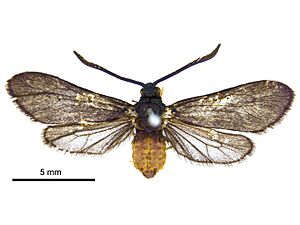Levuana moth facts for kids
Quick facts for kids Levuana moth |
|
|---|---|
 |
|
 |
|
| Conservation status | |
| Scientific classification |
The levuana moth (Levuana iridescens) was a type of moth that is now extinct. It belonged to the Zygaenidae family. This moth was once a huge problem for coconut plants in Fiji. It was the only known species in its group, called Levuana.
Around 1877, the levuana moth became a serious pest for coconut plants on the island of Viti Levu, Fiji. There were often many moths, and their larvae (young moths) ate the underside of coconut leaves. This caused a lot of damage to the coconut palms. Because of this, making copra (dried coconut meat used for oil) became very difficult and not profitable on Viti Levu.
The native people of Fiji relied on coconuts for many things. They used them for food, water, fiber, medicine, fuel, and building materials. The moth threatened their way of life. For about 40 years, the moth stayed mostly on Viti Levu. Many ways to control the pest were tried, like cultural methods and chemicals, but they didn't work well.
Around 1916, the levuana moth started to spread to nearby islands. Then, in 1925, a special program called biological control was started. This program, led by John Douglas Tothill, successfully lowered the moth's huge numbers. After this, it became very hard to find any levuana moths.
Contents
What Did the Levuana Moth Look Like?
The levuana moth was a day-flying insect. It had a wingspan of about 16 mm, which is a bit more than half an inch. Its head and upper body (thorax) were a shiny blue color. Its lower body (abdomen) and legs were a yellowish-brown color, called ochre. In 2019, scientists studied its DNA. They found that it was related to the Australian moth group Myrtartona.
The Moth's History as a Pest
Even though no one has officially seen a Levuana moth since the 1920s, some people think it might have survived in hidden places until the mid-1950s. However, it's thought that this moth probably came from islands west of Fiji, not Fiji itself. This is because Fiji didn't have any natural parasites that attacked the moth.
The young larvae of the Levuana moth ate a lot of coconut tree leaves. Starting in the 1870s, huge groups of these moths would destroy coconut farms. They also damaged nearby native trees. At first, the moth was only found on the Fiji island of Viti Levu. But it eventually spread to other islands, including Vanau Levu, which was a main island for growing coconuts.
Since there were no natural predators or parasites in Fiji, the Levuana population kept growing. It became so large that it was considered a serious pest. Many attempts were made to get rid of the moth, but they all failed. That is, until the biological control program in 1925.
How Was the Moth Controlled?
A Canadian entomologist (an insect scientist) named John Douglas Tothill led the effort to reduce the moth's numbers. He hoped to make the moth population drop a lot. Tothill suggested bringing in a parasite that could attack the Levuana moth. But there wasn't a good parasite available in Fiji.
So, Tothill brought in a special type of parasite called a parasitoid. This parasitoid was a Malaysian fly species named Bessa remota. This fly attacked a moth that was related to the Levuana moth. The Bessa remota fly was very successful. It greatly reduced the number of Levuana moths.
Is the Levuana Moth Really Extinct?
Today, we don't know for sure if the levuana moth is truly extinct. The biological control program greatly reduced the moth's population. But it's still possible that a very small number of them exist today.
The levuana moth liked to attack the tallest coconut palms in certain areas. When these tall palms lost all their leaves, the moths would move to shorter ones. Since there are no longer big outbreaks, some scientists think that if the moths still exist, they live only in their favorite tall trees. They might be in very small numbers, which makes them hard to find. It's believed that if they are still around, they are living on the neighboring islands of Fiji.


